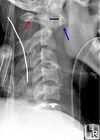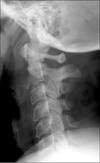Exam 1 (X-Ray Images A) Flashcards
(116 cards)
What do you do when someone comes in with a skull trauma?
REFER out IMMEDIATELY They need a CT
Skull Fractures
Skull is anatomically complex interpretation is very different less than 10% of skull fracture detected on X-rays
Types of Skull Fractures
Depression fractures compound fractures Hairline fractures Subdural hematoma
What’s the diagnosis?

Linear skull fractures are the most commin skull fractures
Pathology

Linear Skull Fracture
-Most common skull fracture
Pathology
-What advanced imaging would help confirm out findings?

Linear skull fracture
-CT is the best imaging utilized for skull fractures
Pathology

Depression Skull Fracture
Pathology
-What name is given to this fractured portion of the face?

Zygomaticomaxillary Complex Fracture (a.k.a. Tripod Fracture)
-Called an “Elephant’s Head” where the ear is the lateral margin of the orbit, the trunk the temporal process of the zygomatic bone and the eye is the infraorbital foramen
Pathology
-What findings help support our Dx?

Blowout Fracture
- Fracture of the floor of the orbit
- Fluid inside the right maxillary sinus (should normally be black from air)
-
What type of classification of facial trauma are these known as?

Le Fort Fractures
What type of Le Fort fracture is this?

Type I
-Maxilla is separate from the face
Pathology

Subdural hematoma
-***Convex shaped***
Pathology

Epidural Hematoma
-***Concave***
What are all the mechanisms of trauma that can cause Spinal trauma?
- Hyperflexion
- Hyperflexion and rotation
- Hyperextension
- Hyperextension with rotation
- Vertical compression
- Lateral flexion
- Other
Trauma associated with hyperflexion injuries
-Which types of trauma are most common and most significant?
- Simple wedge (compression) fracture (MC by far)
- Bilateral interfacetal dislocation
- Flexion teardrop fracture (most significant by far)
- Clay shoveler’s fracture
- Anterior subluxation
- Dens fracture
Traumas associated with hyperflexion and rotation injuries
Occurs along the same side as rotation
- Unilateral interfacetal dislocation
- Unilateral interfacetal fracture–dislocation
Traumas associated with hyperextension injuries
- Avulsion of the anterior tubercle of C1 (rare)
- Hyperextension fracture-dislocation
- Hyperextension dislocation
- Posterior arch fracture of C1
- Extension tear drop fracture
- Hangman’s Fracture
- Lamina fracture
- Dens fracture
Traumas associated with hyperextension-rotation injuries
- Pillar fracture
- Pedicolaminar fracture
Traumas associated with Vertical compression forces
-Can neurologic problems arise from this type of trauma?
- Jefferson’s Fracture of C1
- Burst fracture of the lower cervical spine
- YES, these types of injuries may cause paraplegia or quadriplegia
Traumas associated with Lateral flexion injuries
- Unilateral fracture, lateral mass of C1
- Transverse process fracture
- Uncinate process fracture
Most common locations for spinal trauma
- How common is spinal cord injuries?
- Where is the spine is neurologic injury most common?
C1-C2, C5-C7, T12-L1
- Spinal cord injuries = 10-14% overall
- Neurologic injury = 40% cervicals
Correct order for the Davis Series for the Cervical Spine
-Which film is used to rule out 90% of spinal trauma to the cervicals?
7 views (least to most invasive)
1) Lateral (90% of spinal trauma will be seen here)
2) A-P Open Mouth
3) A-P Cervical
4-5) Left and Right Obliques
6-7) Flexion and Extension
8) Swimmers (OPTIONAL)
Why is this film not an acceptable lateral cervical film for the Davis series?

Does NOT show base of occiput to the top of T1
-If unable to get C7-T1 on the lateral film, should do a Swimmers view
Most significant finding

Increased Retropharyngeal Space
( >7 mm is abnormal)
-Many causes including intubation, fracture, infection, SOL, etc.







































































